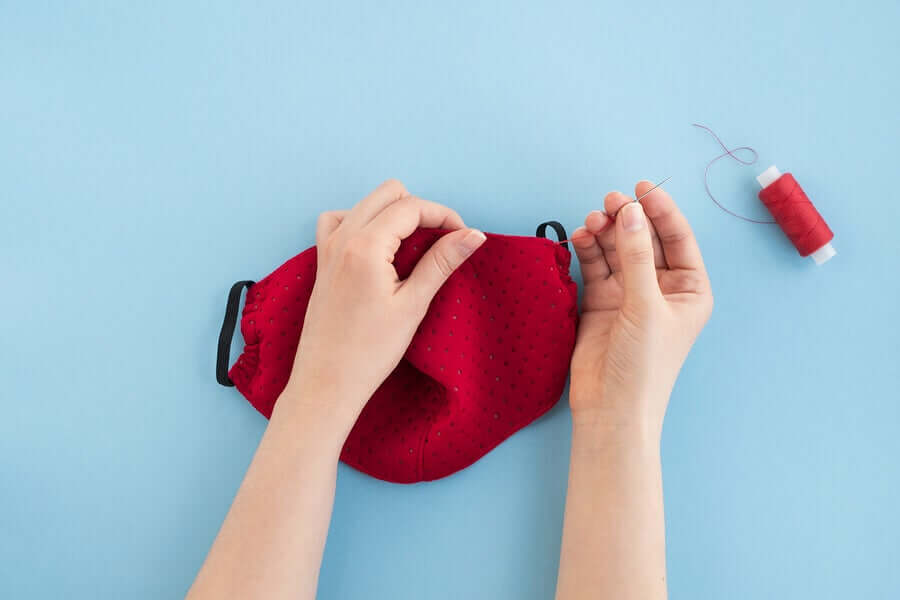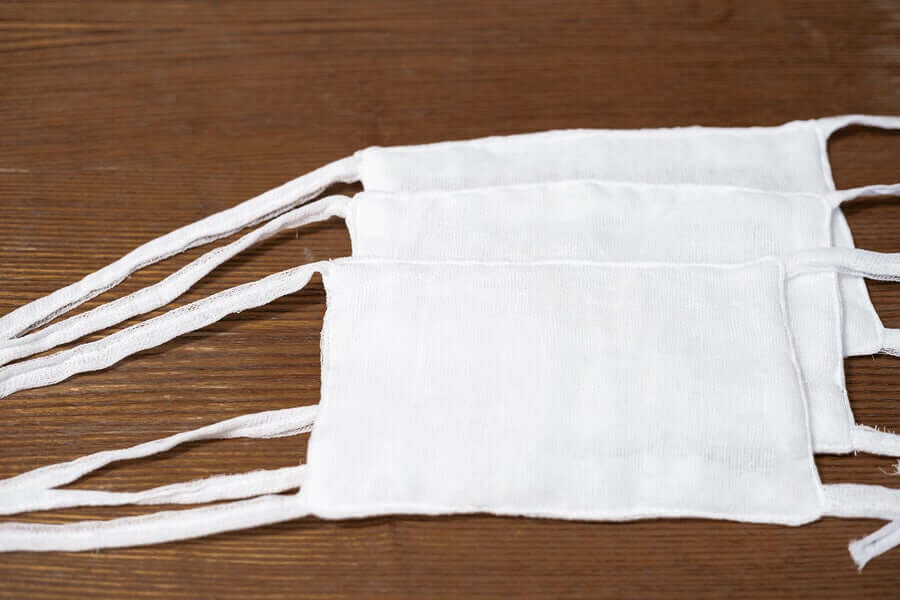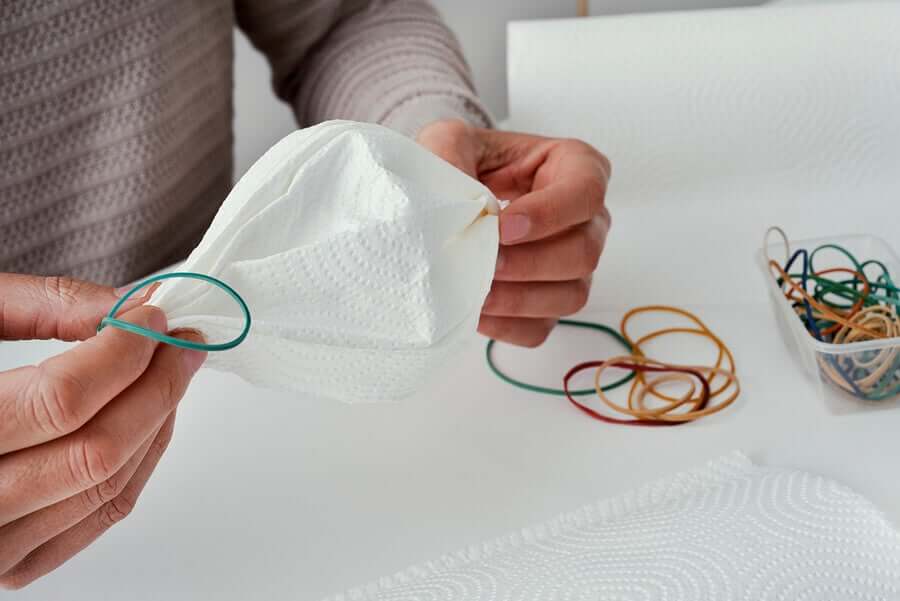Making Cloth Masks to Protect You from COVID-19

The issue of the widespread use of fabric masks as a preventive measure to reduce the spread of COVID-19 remains controversial. Despite this, in recent days the recommendation to use them has gained strength, especially in public places where it’s difficult to maintain social distancing, such as the supermarket or pharmacy. In this article, we’ll be looking at three great ideas for making cloth masks.
It’s clear that masks alone can’t prevent a person from becoming infected. However, they’re a barrier to reducing or delaying the spread of the virus. This is especially the case in asymptomatic people who are unaware that they can transmit the disease to others.
So, can we make cloth masks at home?
The answer is yes. In fact, the Centers for Disease Control and Prevention have shared some simple instructions for people to make their own low-cost masks in cases where high demand makes them difficult to purchase.
Find out the steps here!
Three tutorials for making cloth masks at home
Before we share the instructions for making cloth masks at home, we should be clear about one thing. Both the Centers for Disease Control and Prevention and the World Health Organization and other health authorities have warned that, even though these masks can help to slow the spread of the virus, they don’t provide the level of protection of surgical masks or N95 medical ventilators.
In fact, they point out that the latter options are essential supplies and should, therefore, be reserved for health care personnel. Even so, cloth masks can help increase protection in the population. This is especially helpful considering all the outlay we are having to make for food, medicine, or other essential items.
On the other hand, these entities point out that cloth masks shouldn’t be worn by children under two years of age, or patients with respiratory difficulties. Neither should they be used by those who are unconscious or disabled people who can’t remove their masks without assistance.
Having made all this clear, let’s have a look at the steps.
You may be interested in: Everything You Should Know About Social Distancing
1. Sewn cloth mask
One of the most recommended materials for making cloth masks is cotton. Andrea Burón, spokesperson for the Spanish Society of Public Health and Health Administration (SESPAS) explained to the Spanish newspaper El País that, although there’s no scientific evidence, cotton is, perhaps, the ideal material.
The reason is that, on the one hand, cotton adjusts well to the shape of the face. This ensures there is no reduction in protection due to space between the skin and the mask. On the other hand, it’s a fabric that isn’t usually aggressive towards our skin, as other materials can be.

Materials
- 2 rectangles of thick cotton fabric 25 cm by 15 cm (10 x 6 inches)
- 2 elastic strips, either cloth strips, hair bands, or rubber bands
- Scissors
- Needle and thread
- A sewing machine
Instructions
- To begin with, cut the two fabric rectangles to the above measurements. It’s important to use thick cotton because if it’s thin or worn out, it will reduce its protective capabilities.
- Then, make a small hem on the longer sides, more or less half a centimeter (0.2 inches); and then hem in 1.25 cm (0.5 inches) on the short sides.
- Fix the hems with thread and insert the elastic band into the wider hem. These bands will hold the mask to the ears.
- After inserting the bands into the hem, tie the ends together. Then, pull carefully to ensure the knots are inside the hem.
- Join the ends of the mask together with the elastic so that they fit the size of our face.
- Finally, sew the elastic to prevent it from slipping and to ensure it’s secure.
2. A face mask with a t-shirt and no seam
Maybe you haven’t got any needle or thread, or sewing’s not your thing. Don’t worry, because we’re now going to tell you how to make easy masks using an old t-shirt. (Just make sure it’s not worn out, though!)

Materials
- An old t-shirt
- Scissors
Instructions
- First, cut a piece off the bottom of the t-shirt, with a width of about 20 cm (8 inches)
- Next, take the piece you’ve cut out and cut out a rectangle on each side of between 15 and 17 cm (6 to 7 inches) to make the ties
- Finally, you just have to use the strips to tie the mask onto our neck and the top of your head to make sure it fits well.
Read also: How Long Does Coronavirus Last on Different Surfaces?
3. A mask with a coffee filter and handkerchief
A final option suggested by the CDC to make your own masks also doesn’t require sewing. In this case, it’s a mask made with a coffee filter and a handkerchief. However, it’s important to clarify that this option isn’t reusable.

Materials
- 1 coffee filter
- Handkerchief – 50 cm by 50 cm (20 x 20 inches)
- 2 elastic bands
- Scissors
Instructions
- First, cut the coffee filter to fit the handkerchief.
- Then, fold the handkerchief in half and place the filter in the center of the folded handkerchief.
- Now, fold the top down and the bottom up.
- Insert the elastic bands, about 15 cm (6 inches) apart from each other.
- Bend the sides towards the center and put one end inside the other.
- Finally, check that the mask fits well to your face.
- If you want to use this type of mask again, then make a new one using the same steps.
Fabric masks: Tips to remember
As we mentioned earlier, cloth masks alone don’t provide complete protection against coronavirus (COVID-19). Therefore, it’s important to use them with caution and wash them well before re-using them. Putting them in the washing machine is enough to keep them clean.
On the other hand, when you remove them from your face, you must be careful not to touch your eyes, nose, or mouth without first washing your hands. A good hand wash should last at least 20 seconds.
All cited sources were thoroughly reviewed by our team to ensure their quality, reliability, currency, and validity. The bibliography of this article was considered reliable and of academic or scientific accuracy.
- Centers for Disease Control and Prevention. (2020). Use of Cloth Face Coverings to Help Slow the Spread of COVID-19 | CDC. Available in https://www.cdc.gov/coronavirus/2019-ncov/prevent-getting-sick/diy-cloth-face-coverings.html
- Servick, K. (2020). Would everyone wearing face masks help us slow the pandemic? Science. https://doi.org/10.1126/science.abb9371
- Zafra, M., Rodriguez, B. P. (6 de abril de 2020). Instrucciones para fabricar una mascarilla en casa. El País. Recuperado de https://elpais.com/sociedad/2020/04/04/actualidad/1586014718_239379.html
- Masa, A. (7 de abril de 2020). Cuál es el mejor material para hacer una mascarilla en casa. El País. Recuperado de https://elpais.com/elpais/2020/04/07/buenavida/1586210882_668867.html
- BBC News Mundo. (6 de abril de 2020). Mascarillas de tela: cómo se hacen y cuáles son los errores al usarlas. BBC. Recuperado de https://www.bbc.com/mundo/noticias-52192632
This text is provided for informational purposes only and does not replace consultation with a professional. If in doubt, consult your specialist.








